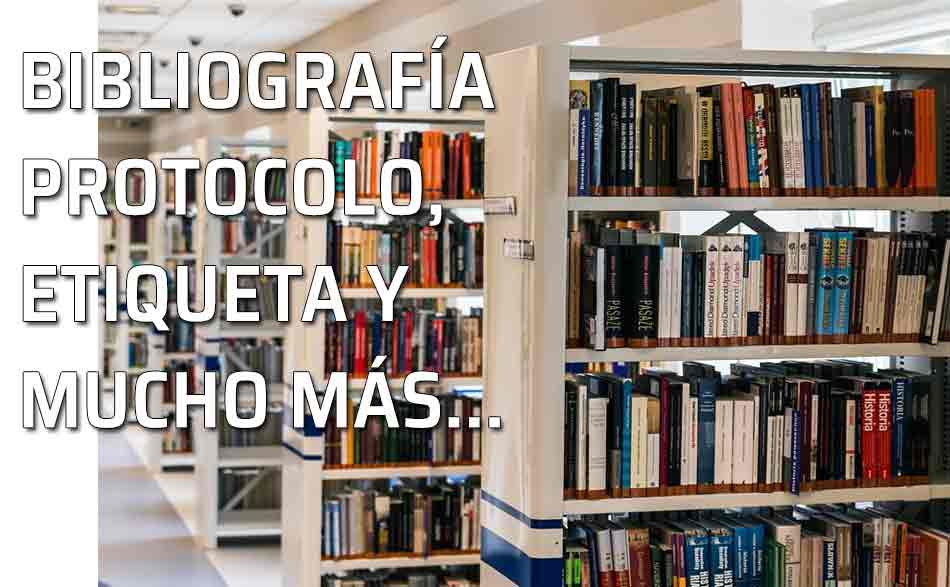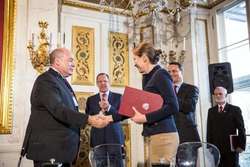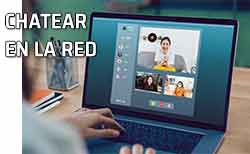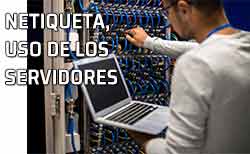
Bibliografía y referencias. Netetiqueta
Bibliografía consultada por el autor para redactar el artículo sobre la Netiqueta de Miguel Zapata Ros

foto base jarmoluk - Pixabay
Libros y documentos consultados para redactar el artículo sobre la Netiqueta
BIBLIOGRAFÍA Y REFERENCIAS.
Angell, D., and B. Heslop, 1994. "The Elements of E-mail Style", New York: Addison-Wesley, 1994.
B.O.E., 2002. SERVICIOS DE LA SOCIEDAD DE LA INFORMACIÓN Y DE COMERCIO ELECTRÓNICO. LEY 34/2002, de 11 de julio, de servicios de la sociedad de la información y de comercio electrónico. (B.O.E. 12-07-2002)
http://www.aeat.es/normlegi/ecomercio/ley342002.htm
(Web de la Agencia Tributaria)
B.O.E., 2002-b Corrección de errores a la. LEY 34/2002, de 11 de julio, de servicios de la sociedad de la información y de comercio electrónico (B.O.E. 12-07-2002). B.O.E. 06/08/2002
Bradley University . "Heartland Free-Net Registered User Guidelines", Bradley University, Peoria, IL.
Cerf, V., "Guidelines for Conduct on and Use of Internet", at: http://www.isoc.org/policy/conduct/conduct.html
CREN Information Center , 1990. "Terms and Conditions of Membership and Affiliation", CREN Information Center, October 25, 1990
Dern, D., 1994. "The Internet Guide for New Users", New York: McGraw-Hill, 1994.
El Pais - Javier Martín, 2001. La futura ley del comercio electrónico, contra el 'spam'. Ciberpais, 3 de mayo de 2001
http://www.ciberpais.elpais.es
El Pais - Javier Martín, 2001 b. El internauta estará obligado a declarar que no desea correo comercial.. Año 2005: 'Spam is different' El comprador podrá pleitar en España
"Emily Postnews Answers Your Questions on Netiquette" Original author: brad@looking.on.ca (Brad Templeton) Maintained by: netannounce@deshaw.com (Mark Moraes) Archive-name: emily-postnews/part1
Esebbag Benchimol, C. et al.: "Guía práctica para usuarios de Internet"; Anaya Multimedia, 1996
Gaffin, A., "Everybody's Guide to the Internet", Cambridge, Mass., MIT Press, 1994.
Gargano, Joan "A Guide to Electronic Communication & Network Etiquette", revised and submitted by Joan Gargano, edited by Ivars Balkits, Computing Services- University of California Davis.
Wiggins, R., "The Internet for everyone: a guide for users and providers", New York, McGraw-Hill, 1995.
"Guidelines for Responsible Use of the Internet" from the US house of Representatives gopher, at:
gopher://gopher.house.gov:70/OF-InternetEtiquette* No disponible ya.
Horton, Mark; Spafford, Gene. "Rules of conduct on Usenet"
How to find the right place to post (FAQ) by buglady@bronze.lcs.mit.edu (Aliza R. Panitz) Archive-name: finding-groups/general
Hambridge, S., and J. Sedayao, "Horses and Barn Doors: Evolution of Corporate Guidelines for Internet Usage", LISA VII, Usenix, November 1-5, 1993, pp. 9-16.
ftp://ftp.intel.com/pub/papers/horses.ps
Heslop, B., and D. Angell, "The Instant Internet guide: Hands-on Global Networking", Reading, Mass., Addison-Wesley, 1994.
Horwitz, S., "Internet Etiquette Tips",
ftp://ftp.temple.edu/pub/info/help-net/netiquette
Internet Activities Board, "Ethics and the Internet", RFC 1087,IAB, January 1989.
ftp://ds.internic.net/rfc/rfc1087.txt
Joyanes, L. "Cibersociedad"; McGraw-Hill, Madrid, 1997
Kehoe, Brendan P. "A Beginner's Guide to the Internet: Zen and the Art of the Internet", First Edition, January 1992.
Kehoe, B., "Zen and the Art of the Internet: A Beginner's Guide", Netiquette information is spread through the chapters of this work. 3rd ed. Englewood Cliffs, NJ., Prentice-Hall, 1994.
Kochmer, J., "Internet Passport: NorthWestNet's Guide to our World Online", 4th ed. Bellevue, Wash., NorthWestNet, Northwest Academic Computing Consortium, 1993.
Krol, Ed, "The Whole Internet: User's Guide and Catalog", Sebastopol, CA, O'Reilly & Associates, 1992.
Lane, E. and C. Summerhill, "Internet Primer for Information Professionals: a basic guide to Internet networking technology", Westport, CT, Meckler, 1993.
LaQuey, T., and J. Ryer, "The Internet Companion", Chapter 3 "Communicating with People", pp 41-74. Reading, MA, Addison-Wesley, 1993.
Mandel, T., "Surfing the Wild Internet", SRI International Business Intelligence Program, Scan No. 2109. March, 1993.
gopher://gopher.well.sf.ca.us:70/00/Communications/* No disponible ya.
Martin, J., "There's Gold in them thar Networks! or Searching for Treasure in all the Wrong Places", FYI 10, RFC 1402, January 1993.
ftp://ds.internic.net/rfc/rfc1402.txt
McLuhan, M. et al.: "La aldeal global";Editorial Gedisa, Colección El Mamífero Parlante, Barcelona, 1993.
Piscitelli, A.: "ciberculturas"; Paidos, Buenos Aires, 1995.
Pioch, N., "A Short IRC Primer", Text conversion by Owe Rasmussen. Edition 1.1b, February 28, 1993.
http://www.kei.com/irc/IRCprimer1.1.txt
Polly, J., "Surfing the Internet: an Introduction", Version 2.0.3. Revised May 15, 1993.
ftp://ftp.nysernet.org/pub/resources/guides/
Red Iris 1996-2002 Centro de comunicaciones CSIC/RedIRIS, Abuso en el correo electrónico Otras referencias.
http://www.rediris.es/mail/abuso/mas.es.html#herr
Rinaldi, Arlene H. (1998), The Net: User Guidelines and Netiquette
http://www.fau.edu/netiquette/net/
http://www.fau.edu/rinaldi
Shaffer, Deborah. "Exploring Internet Training Series, Module 1- Exploring Internet:Using your Computer to Communicate", by Deborah Shaffer, ES-USDA, CIT and Pennsylvania State University, Henry DeVries; Extension Electronic Technology Group, Cornell University; Gregory Parham, ES-USDA, CIT.
Shaffer, Deborah. "Exploring Internet Training Series, Module 2- Mail-based Information Delivery: Alamanac and Listservs". by Deborah Shaffer, ES-USDA, CIT and Pennsylavia State University; Henry DeVries, Extension Electronic Technology Group, Cornell University; Gregory Parham, ES_USDA, CIT.
Shapiro, Norman, et al. "Towards an Ethics and Etiquette for Electronic Mail"., Santa Monica, CA: Rand Corporation (publication R-3283-NSF/RC), 1985.
Schwarz, Jerry."Answers to Frequently Asked Questions about Usenet"
Original author: jerry@eagle.UUCP (Jerry Schwarz) Maintained by: netannounce@deshaw.com (Mark Moraes) Archive-name: usenet-faq/part1
Shea, V., "Netiquette", San Francisco: Albion Books, 1994.
Spafford, Gene. "Rules for posting to Usenet"
Original author: spaf@cs.purdue.edu (Gene Spafford) Maintained by: netannounce@deshaw.com (Mark Moraes) Archive-name: posting-rules/part1
Strangelove, M., with A. Bosley, "How to Advertise on the Internet", ISSN 1201-0758.
Sanz, Jesús 2002, El spam prohibido por Ley. RedIRIS - Actualidad. Boletín Red Iris número 60 (abril 2002)
http://www.rediris.es/rediris/boletin/60/
Tenant, R., "Internet Basics", ERIC Clearinghouse of Information Resources, EDO-IR-92-7. September, 1992.
Terceiro, J. B.: "Socied@d digit@l", Alianza Editorial, Madrid, 1996
Trejo Delarbe, R.: "La nueva alfombra mágica"; FUNDESCO, 1996; Colección Impactos.
Turkle, S.. "La vida en la pantalla"; Paidos, Barcelona, 1995
Updegrove, Dan et al., "Electronic Mail and Networks: New Tools for Institutional Research and Planning." by Dan Updegrove, John Muffo and Jack Dunn, University of Pennsylvania.
Varios autores: "Apuntes de la sociedad interactiva"; FUNDESCO, 1994;
Colección Encuentros
Von Rospach, Chuq. "A Primer on How to Work With the Usenet Community"
Original author: chuq@apple.com (Chuq Von Rospach) Maintained by: netannounce@deshaw.com (Mark Moraes) Archive-name: usenet-primer/part1
Historia de Internet, Internet y sociedad.
Miguel Ángel Sanz, 1994. A, B, C de Internet, . Boletín Red Iris numero 28 julio 1994, Enfoques
http://www.rediris.es/rediris/boletin/28/enfoque1
Miguel A. Sanz Fundamentos históricos de la Internet en Europa y en España Boletín Red Iris numero 45 octubre 1998, Enfoques 2
http://www.rediris.es/rediris/boletin/45/enfoque2
José Antonio Millán 1999-2000 José Antonio Millán Breve Historia de la Internet. El fruto caliente de la guerra fría.
http://jamillan.com/histoint.htm
Barry M. Leiner, Vinton G. Cerf, David D. Clark, Robert E. Kahn, Leonard Kleinrock, Daniel C. Lynch, Jon Postel, Lawrence G. Roberts, Stephen Wolff
Una breve historia de Internet. Versión española en ATI, 1999.
http://www.ati.es/DOCS/internet/histint/
A Brief History of Internet.A Brief History of the Internet, version 3.31. Last revised 4 Aug 2000
http://www.isoc.org/internet/history/brief.shtml
La buenas maneras en Internet.
- Las buenas maneras en Internet. Netetiqueta. Introducción.
- Netetiqueta. Situación actual de la red.
- Netetiqueta. Internet: Privilegio y responsabilidad.
- Justificación. Necesidad de la netiquette.
- Necesidad de suplir otros códigos comunicacionales directos o explícitos.
- Necesidades derivadas de la propia infraestructura tecnológica.
- Necesidades de definir unos protocolos de comunicación propios.
- La ética de La Red. Netetiqueta.
- Algunas de las más importantes reglas, su origen y sentido.
- El correo del modem para adentro. El disco duro. Netetiqueta.
- Mensajería. Netetiqueta.
- Listas de distribución. Grupos Listserv. Netetiqueta.
- Web. Ftp. Telnet. Netetiqueta.
- Bibliografía y referencias. Netetiqueta.
Su opinión es importante.
Participe y aporte su visión sobre este artículo, o ayude a otros usuarios con su conocimiento.
-
¿Qué ponemos en el llamado asunto o título del correo? ¿Cómo nos presentamos? ¿Cómo nos despedimos?
-
Netiqueta (o Netiquette) es una palabra derivada del francés étiquette y del inglés net o network (red) y se refiere al conjunto de reglas que regulan el comportamiento de un usuario que interactúe en internet, sea en foros, blogs o al usar correo
-
Las habilidades sociales se desarrollan a lo largo de la vida de una persona en su relación con los demás y en el seno de la familia
-
La reputación digital es la opinión que los demás tienen de nosotros basada en las cosas que hacemos en 'internet'. Comentario, fotos, vídeos... todo es válido para generar una opinión determinada sobre nosotros
-
Cuando hablamos con otras personas debemos ser respetuosos y educados, aunque no sepamos quién esta al otro lado
-
Conversar utilizando el ordenador, no difiere mucho de hacerlo por cualquier otro medio.
-
Nunca debemos olvidar, que aunque tratemos con máquinas, al otro lado, siempre hay una persona
-
Los teléfonos móviles -celulares- cada vez están más presentes en nuestra vida cotidiana, tanto en el ámbito privado como en el público
-
La tecnología ha cambiado las normas sociales. El uso del móvil e Internet distorsiona la convivencia, y las nuevas reglas se imponen.
-
Si programamos de forma adecuada nuestros accesos a la Red, lograremos que sea más rápida y el tráfico más fluido
-
Los buenos modales son necesarios tanto en los encuentros presenciales como en los virtuales
-
Para no verte como alguien sin educación virtual, ponte al día con las reglas de cortesía establecidas







